Customer Journey Report of Wework
VerifiedAdded on 2022/02/25
|10
|2986
|26
AI Summary
Considering that a member of a coworking space is interested in the service, the Coworking Customer Trip is a useful marketing tool to design the user experience and the full journey the member takes.
Contribute Materials
Your contribution can guide someone’s learning journey. Share your
documents today.
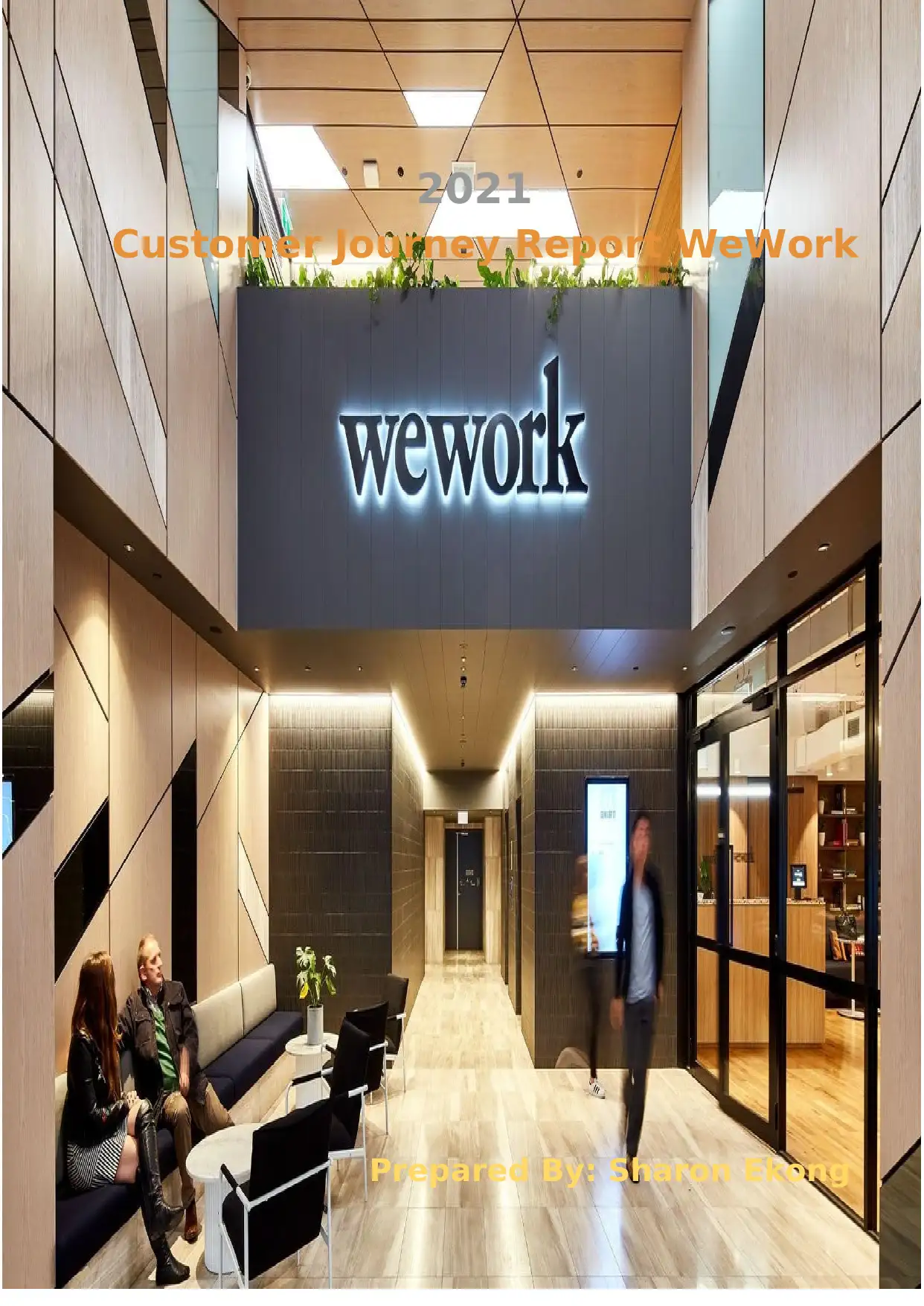
2021
Customer Journey Report WeWork
Prepared By: Sharon Ekong
Customer Journey Report WeWork
Prepared By: Sharon Ekong
Secure Best Marks with AI Grader
Need help grading? Try our AI Grader for instant feedback on your assignments.
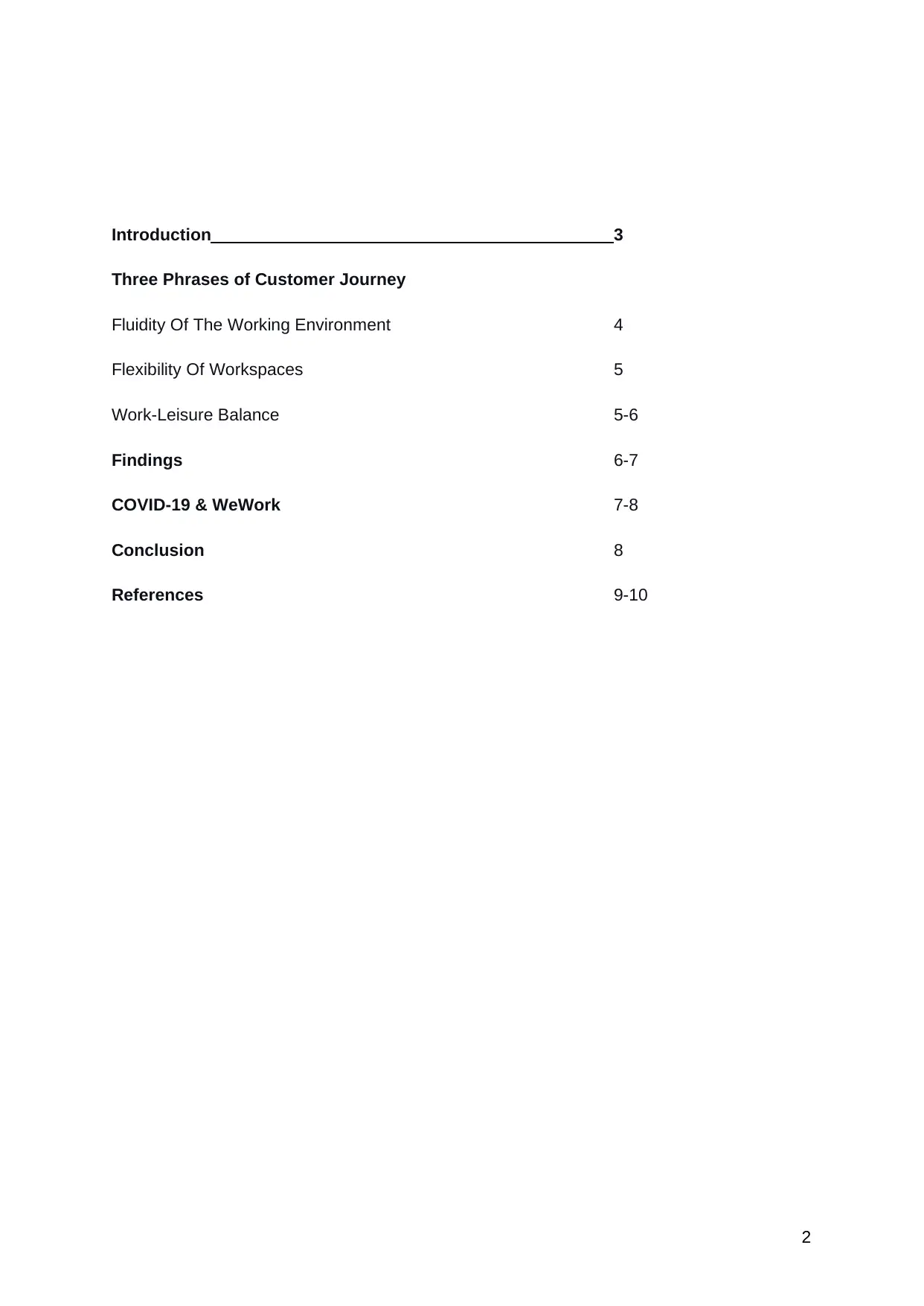
Introduction 3
Three Phrases of Customer Journey
Fluidity Of The Working Environment 4
Flexibility Of Workspaces 5
Work-Leisure Balance 5-6
Findings 6-7
COVID-19 & WeWork 7-8
Conclusion 8
References 9-10
2
Three Phrases of Customer Journey
Fluidity Of The Working Environment 4
Flexibility Of Workspaces 5
Work-Leisure Balance 5-6
Findings 6-7
COVID-19 & WeWork 7-8
Conclusion 8
References 9-10
2
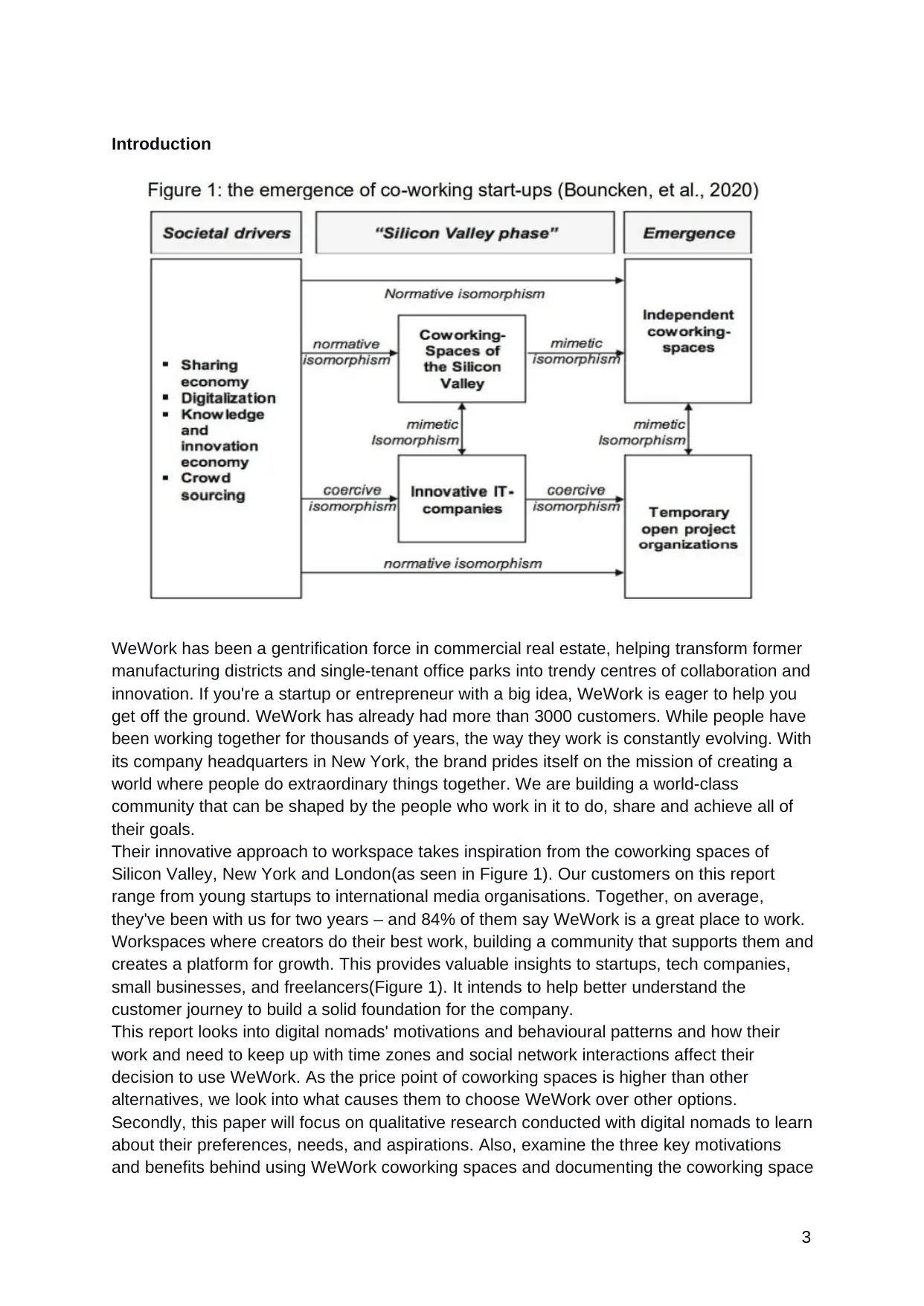
Introduction
WeWork has been a gentrification force in commercial real estate, helping transform former
manufacturing districts and single-tenant office parks into trendy centres of collaboration and
innovation. If you're a startup or entrepreneur with a big idea, WeWork is eager to help you
get off the ground. WeWork has already had more than 3000 customers. While people have
been working together for thousands of years, the way they work is constantly evolving. With
its company headquarters in New York, the brand prides itself on the mission of creating a
world where people do extraordinary things together. We are building a world-class
community that can be shaped by the people who work in it to do, share and achieve all of
their goals.
Their innovative approach to workspace takes inspiration from the coworking spaces of
Silicon Valley, New York and London(as seen in Figure 1). Our customers on this report
range from young startups to international media organisations. Together, on average,
they've been with us for two years – and 84% of them say WeWork is a great place to work.
Workspaces where creators do their best work, building a community that supports them and
creates a platform for growth. This provides valuable insights to startups, tech companies,
small businesses, and freelancers(Figure 1). It intends to help better understand the
customer journey to build a solid foundation for the company.
This report looks into digital nomads' motivations and behavioural patterns and how their
work and need to keep up with time zones and social network interactions affect their
decision to use WeWork. As the price point of coworking spaces is higher than other
alternatives, we look into what causes them to choose WeWork over other options.
Secondly, this paper will focus on qualitative research conducted with digital nomads to learn
about their preferences, needs, and aspirations. Also, examine the three key motivations
and benefits behind using WeWork coworking spaces and documenting the coworking space
3
WeWork has been a gentrification force in commercial real estate, helping transform former
manufacturing districts and single-tenant office parks into trendy centres of collaboration and
innovation. If you're a startup or entrepreneur with a big idea, WeWork is eager to help you
get off the ground. WeWork has already had more than 3000 customers. While people have
been working together for thousands of years, the way they work is constantly evolving. With
its company headquarters in New York, the brand prides itself on the mission of creating a
world where people do extraordinary things together. We are building a world-class
community that can be shaped by the people who work in it to do, share and achieve all of
their goals.
Their innovative approach to workspace takes inspiration from the coworking spaces of
Silicon Valley, New York and London(as seen in Figure 1). Our customers on this report
range from young startups to international media organisations. Together, on average,
they've been with us for two years – and 84% of them say WeWork is a great place to work.
Workspaces where creators do their best work, building a community that supports them and
creates a platform for growth. This provides valuable insights to startups, tech companies,
small businesses, and freelancers(Figure 1). It intends to help better understand the
customer journey to build a solid foundation for the company.
This report looks into digital nomads' motivations and behavioural patterns and how their
work and need to keep up with time zones and social network interactions affect their
decision to use WeWork. As the price point of coworking spaces is higher than other
alternatives, we look into what causes them to choose WeWork over other options.
Secondly, this paper will focus on qualitative research conducted with digital nomads to learn
about their preferences, needs, and aspirations. Also, examine the three key motivations
and benefits behind using WeWork coworking spaces and documenting the coworking space
3
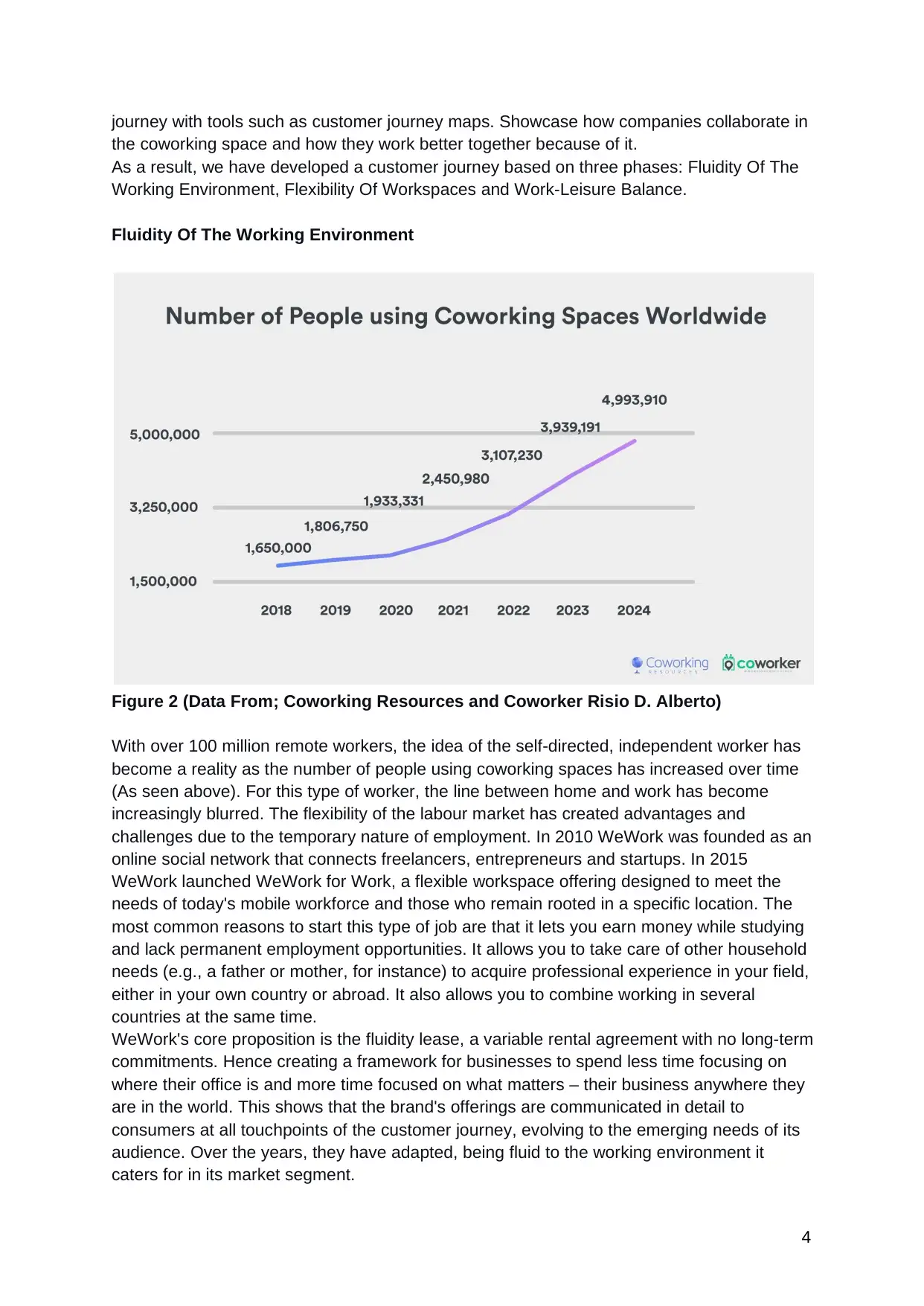
journey with tools such as customer journey maps. Showcase how companies collaborate in
the coworking space and how they work better together because of it.
As a result, we have developed a customer journey based on three phases: Fluidity Of The
Working Environment, Flexibility Of Workspaces and Work-Leisure Balance.
Fluidity Of The Working Environment
Figure 2 (Data From; Coworking Resources and Coworker Risio D. Alberto)
With over 100 million remote workers, the idea of the self-directed, independent worker has
become a reality as the number of people using coworking spaces has increased over time
(As seen above). For this type of worker, the line between home and work has become
increasingly blurred. The flexibility of the labour market has created advantages and
challenges due to the temporary nature of employment. In 2010 WeWork was founded as an
online social network that connects freelancers, entrepreneurs and startups. In 2015
WeWork launched WeWork for Work, a flexible workspace offering designed to meet the
needs of today's mobile workforce and those who remain rooted in a specific location. The
most common reasons to start this type of job are that it lets you earn money while studying
and lack permanent employment opportunities. It allows you to take care of other household
needs (e.g., a father or mother, for instance) to acquire professional experience in your field,
either in your own country or abroad. It also allows you to combine working in several
countries at the same time.
WeWork's core proposition is the fluidity lease, a variable rental agreement with no long-term
commitments. Hence creating a framework for businesses to spend less time focusing on
where their office is and more time focused on what matters – their business anywhere they
are in the world. This shows that the brand's offerings are communicated in detail to
consumers at all touchpoints of the customer journey, evolving to the emerging needs of its
audience. Over the years, they have adapted, being fluid to the working environment it
caters for in its market segment.
4
the coworking space and how they work better together because of it.
As a result, we have developed a customer journey based on three phases: Fluidity Of The
Working Environment, Flexibility Of Workspaces and Work-Leisure Balance.
Fluidity Of The Working Environment
Figure 2 (Data From; Coworking Resources and Coworker Risio D. Alberto)
With over 100 million remote workers, the idea of the self-directed, independent worker has
become a reality as the number of people using coworking spaces has increased over time
(As seen above). For this type of worker, the line between home and work has become
increasingly blurred. The flexibility of the labour market has created advantages and
challenges due to the temporary nature of employment. In 2010 WeWork was founded as an
online social network that connects freelancers, entrepreneurs and startups. In 2015
WeWork launched WeWork for Work, a flexible workspace offering designed to meet the
needs of today's mobile workforce and those who remain rooted in a specific location. The
most common reasons to start this type of job are that it lets you earn money while studying
and lack permanent employment opportunities. It allows you to take care of other household
needs (e.g., a father or mother, for instance) to acquire professional experience in your field,
either in your own country or abroad. It also allows you to combine working in several
countries at the same time.
WeWork's core proposition is the fluidity lease, a variable rental agreement with no long-term
commitments. Hence creating a framework for businesses to spend less time focusing on
where their office is and more time focused on what matters – their business anywhere they
are in the world. This shows that the brand's offerings are communicated in detail to
consumers at all touchpoints of the customer journey, evolving to the emerging needs of its
audience. Over the years, they have adapted, being fluid to the working environment it
caters for in its market segment.
4
Secure Best Marks with AI Grader
Need help grading? Try our AI Grader for instant feedback on your assignments.
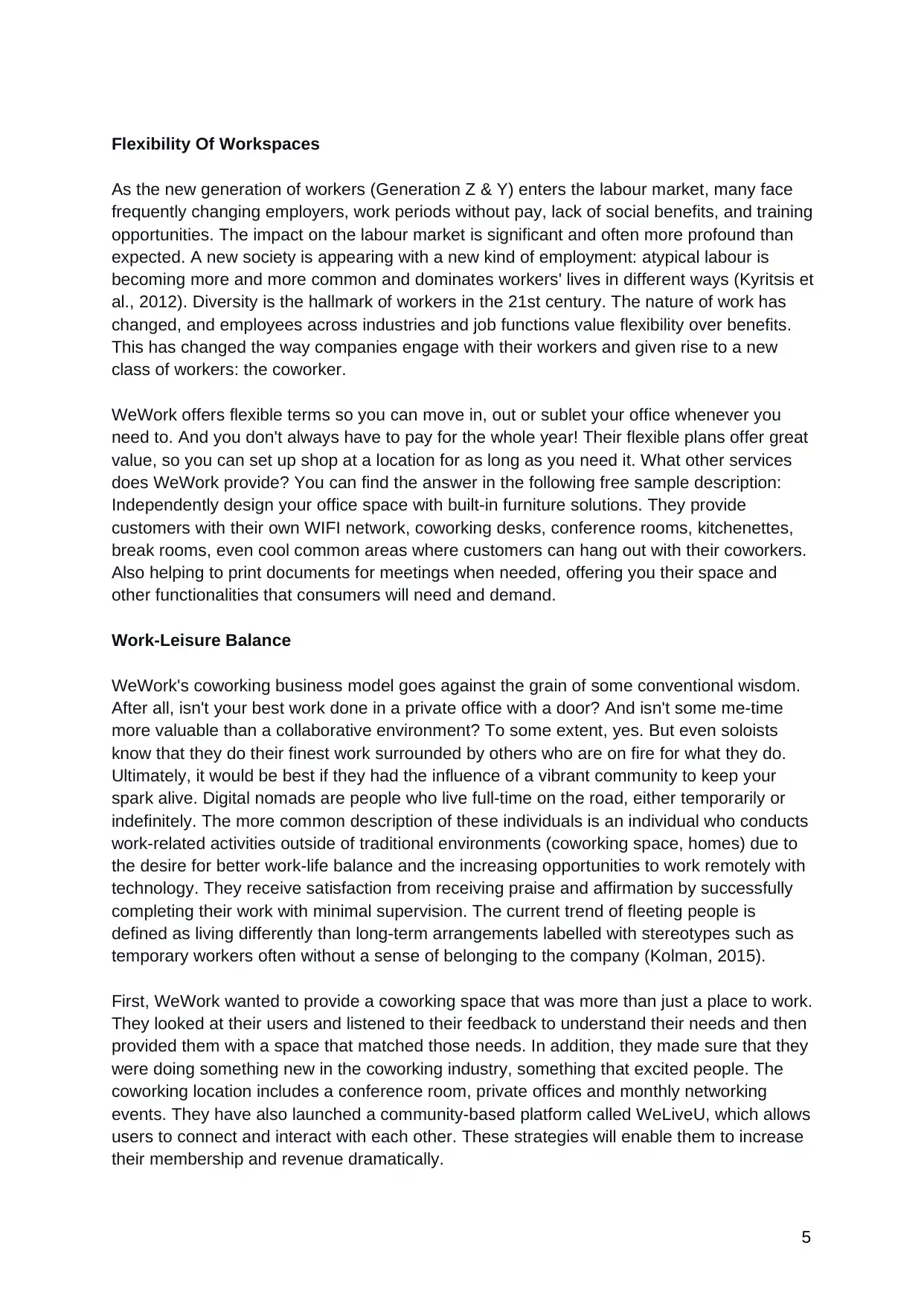
Flexibility Of Workspaces
As the new generation of workers (Generation Z & Y) enters the labour market, many face
frequently changing employers, work periods without pay, lack of social benefits, and training
opportunities. The impact on the labour market is significant and often more profound than
expected. A new society is appearing with a new kind of employment: atypical labour is
becoming more and more common and dominates workers' lives in different ways (Kyritsis et
al., 2012). Diversity is the hallmark of workers in the 21st century. The nature of work has
changed, and employees across industries and job functions value flexibility over benefits.
This has changed the way companies engage with their workers and given rise to a new
class of workers: the coworker.
WeWork offers flexible terms so you can move in, out or sublet your office whenever you
need to. And you don't always have to pay for the whole year! Their flexible plans offer great
value, so you can set up shop at a location for as long as you need it. What other services
does WeWork provide? You can find the answer in the following free sample description:
Independently design your office space with built-in furniture solutions. They provide
customers with their own WIFI network, coworking desks, conference rooms, kitchenettes,
break rooms, even cool common areas where customers can hang out with their coworkers.
Also helping to print documents for meetings when needed, offering you their space and
other functionalities that consumers will need and demand.
Work-Leisure Balance
WeWork's coworking business model goes against the grain of some conventional wisdom.
After all, isn't your best work done in a private office with a door? And isn't some me-time
more valuable than a collaborative environment? To some extent, yes. But even soloists
know that they do their finest work surrounded by others who are on fire for what they do.
Ultimately, it would be best if they had the influence of a vibrant community to keep your
spark alive. Digital nomads are people who live full-time on the road, either temporarily or
indefinitely. The more common description of these individuals is an individual who conducts
work-related activities outside of traditional environments (coworking space, homes) due to
the desire for better work-life balance and the increasing opportunities to work remotely with
technology. They receive satisfaction from receiving praise and affirmation by successfully
completing their work with minimal supervision. The current trend of fleeting people is
defined as living differently than long-term arrangements labelled with stereotypes such as
temporary workers often without a sense of belonging to the company (Kolman, 2015).
First, WeWork wanted to provide a coworking space that was more than just a place to work.
They looked at their users and listened to their feedback to understand their needs and then
provided them with a space that matched those needs. In addition, they made sure that they
were doing something new in the coworking industry, something that excited people. The
coworking location includes a conference room, private offices and monthly networking
events. They have also launched a community-based platform called WeLiveU, which allows
users to connect and interact with each other. These strategies will enable them to increase
their membership and revenue dramatically.
5
As the new generation of workers (Generation Z & Y) enters the labour market, many face
frequently changing employers, work periods without pay, lack of social benefits, and training
opportunities. The impact on the labour market is significant and often more profound than
expected. A new society is appearing with a new kind of employment: atypical labour is
becoming more and more common and dominates workers' lives in different ways (Kyritsis et
al., 2012). Diversity is the hallmark of workers in the 21st century. The nature of work has
changed, and employees across industries and job functions value flexibility over benefits.
This has changed the way companies engage with their workers and given rise to a new
class of workers: the coworker.
WeWork offers flexible terms so you can move in, out or sublet your office whenever you
need to. And you don't always have to pay for the whole year! Their flexible plans offer great
value, so you can set up shop at a location for as long as you need it. What other services
does WeWork provide? You can find the answer in the following free sample description:
Independently design your office space with built-in furniture solutions. They provide
customers with their own WIFI network, coworking desks, conference rooms, kitchenettes,
break rooms, even cool common areas where customers can hang out with their coworkers.
Also helping to print documents for meetings when needed, offering you their space and
other functionalities that consumers will need and demand.
Work-Leisure Balance
WeWork's coworking business model goes against the grain of some conventional wisdom.
After all, isn't your best work done in a private office with a door? And isn't some me-time
more valuable than a collaborative environment? To some extent, yes. But even soloists
know that they do their finest work surrounded by others who are on fire for what they do.
Ultimately, it would be best if they had the influence of a vibrant community to keep your
spark alive. Digital nomads are people who live full-time on the road, either temporarily or
indefinitely. The more common description of these individuals is an individual who conducts
work-related activities outside of traditional environments (coworking space, homes) due to
the desire for better work-life balance and the increasing opportunities to work remotely with
technology. They receive satisfaction from receiving praise and affirmation by successfully
completing their work with minimal supervision. The current trend of fleeting people is
defined as living differently than long-term arrangements labelled with stereotypes such as
temporary workers often without a sense of belonging to the company (Kolman, 2015).
First, WeWork wanted to provide a coworking space that was more than just a place to work.
They looked at their users and listened to their feedback to understand their needs and then
provided them with a space that matched those needs. In addition, they made sure that they
were doing something new in the coworking industry, something that excited people. The
coworking location includes a conference room, private offices and monthly networking
events. They have also launched a community-based platform called WeLiveU, which allows
users to connect and interact with each other. These strategies will enable them to increase
their membership and revenue dramatically.
5
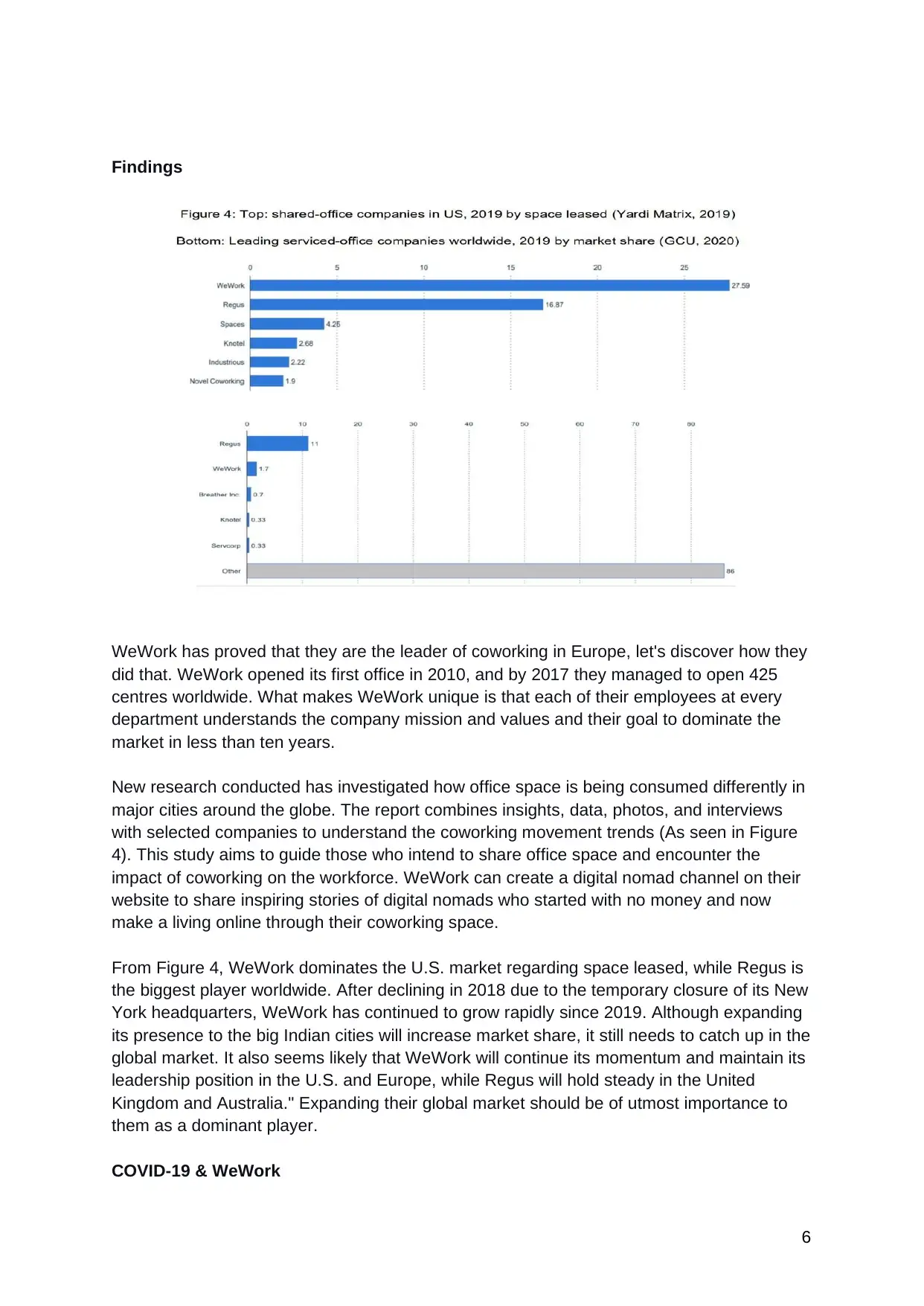
Findings
WeWork has proved that they are the leader of coworking in Europe, let's discover how they
did that. WeWork opened its first office in 2010, and by 2017 they managed to open 425
centres worldwide. What makes WeWork unique is that each of their employees at every
department understands the company mission and values and their goal to dominate the
market in less than ten years.
New research conducted has investigated how office space is being consumed differently in
major cities around the globe. The report combines insights, data, photos, and interviews
with selected companies to understand the coworking movement trends (As seen in Figure
4). This study aims to guide those who intend to share office space and encounter the
impact of coworking on the workforce. WeWork can create a digital nomad channel on their
website to share inspiring stories of digital nomads who started with no money and now
make a living online through their coworking space.
From Figure 4, WeWork dominates the U.S. market regarding space leased, while Regus is
the biggest player worldwide. After declining in 2018 due to the temporary closure of its New
York headquarters, WeWork has continued to grow rapidly since 2019. Although expanding
its presence to the big Indian cities will increase market share, it still needs to catch up in the
global market. It also seems likely that WeWork will continue its momentum and maintain its
leadership position in the U.S. and Europe, while Regus will hold steady in the United
Kingdom and Australia." Expanding their global market should be of utmost importance to
them as a dominant player.
COVID-19 & WeWork
6
WeWork has proved that they are the leader of coworking in Europe, let's discover how they
did that. WeWork opened its first office in 2010, and by 2017 they managed to open 425
centres worldwide. What makes WeWork unique is that each of their employees at every
department understands the company mission and values and their goal to dominate the
market in less than ten years.
New research conducted has investigated how office space is being consumed differently in
major cities around the globe. The report combines insights, data, photos, and interviews
with selected companies to understand the coworking movement trends (As seen in Figure
4). This study aims to guide those who intend to share office space and encounter the
impact of coworking on the workforce. WeWork can create a digital nomad channel on their
website to share inspiring stories of digital nomads who started with no money and now
make a living online through their coworking space.
From Figure 4, WeWork dominates the U.S. market regarding space leased, while Regus is
the biggest player worldwide. After declining in 2018 due to the temporary closure of its New
York headquarters, WeWork has continued to grow rapidly since 2019. Although expanding
its presence to the big Indian cities will increase market share, it still needs to catch up in the
global market. It also seems likely that WeWork will continue its momentum and maintain its
leadership position in the U.S. and Europe, while Regus will hold steady in the United
Kingdom and Australia." Expanding their global market should be of utmost importance to
them as a dominant player.
COVID-19 & WeWork
6
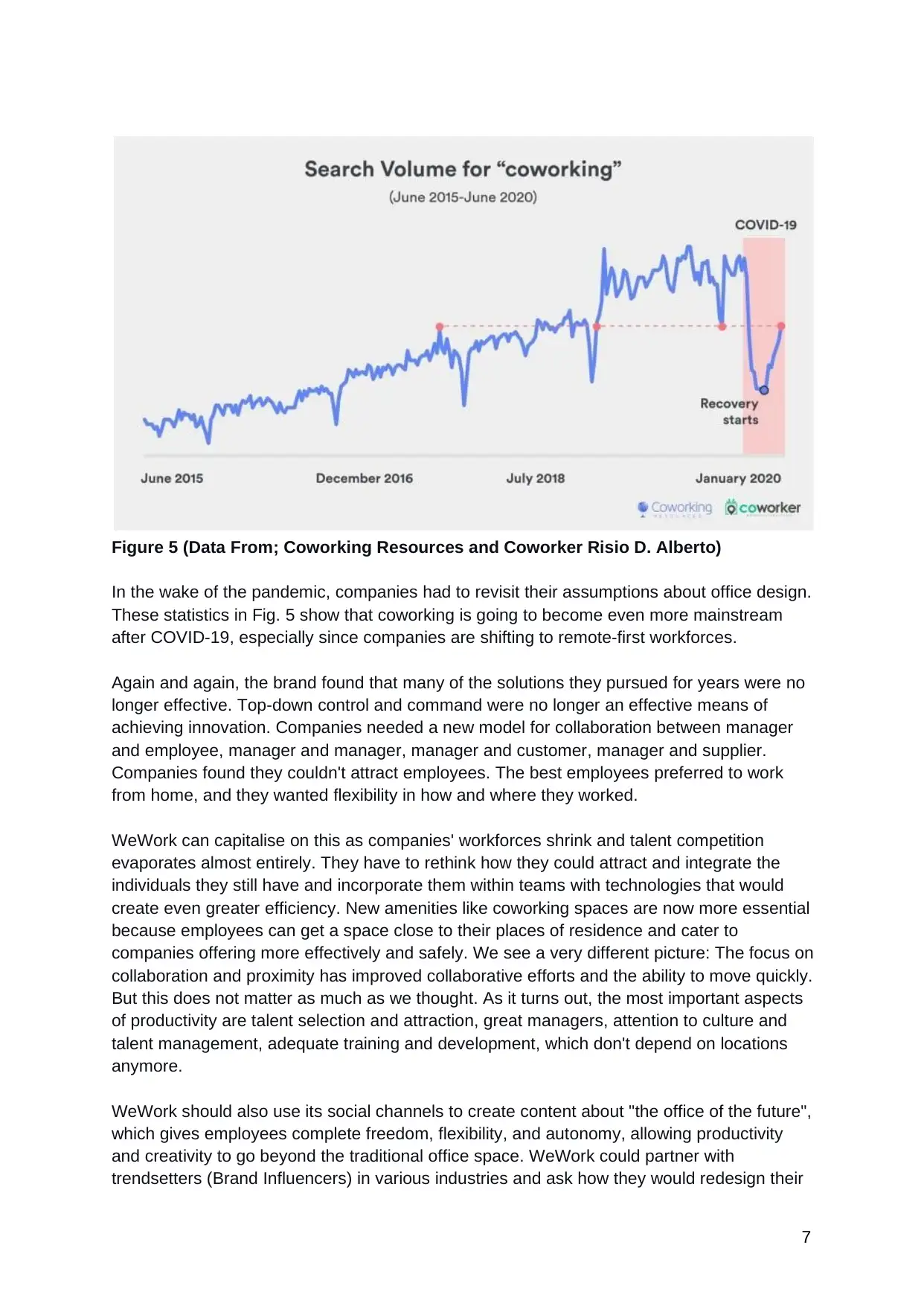
Figure 5 (Data From; Coworking Resources and Coworker Risio D. Alberto)
In the wake of the pandemic, companies had to revisit their assumptions about office design.
These statistics in Fig. 5 show that coworking is going to become even more mainstream
after COVID-19, especially since companies are shifting to remote-first workforces.
Again and again, the brand found that many of the solutions they pursued for years were no
longer effective. Top-down control and command were no longer an effective means of
achieving innovation. Companies needed a new model for collaboration between manager
and employee, manager and manager, manager and customer, manager and supplier.
Companies found they couldn't attract employees. The best employees preferred to work
from home, and they wanted flexibility in how and where they worked.
WeWork can capitalise on this as companies' workforces shrink and talent competition
evaporates almost entirely. They have to rethink how they could attract and integrate the
individuals they still have and incorporate them within teams with technologies that would
create even greater efficiency. New amenities like coworking spaces are now more essential
because employees can get a space close to their places of residence and cater to
companies offering more effectively and safely. We see a very different picture: The focus on
collaboration and proximity has improved collaborative efforts and the ability to move quickly.
But this does not matter as much as we thought. As it turns out, the most important aspects
of productivity are talent selection and attraction, great managers, attention to culture and
talent management, adequate training and development, which don't depend on locations
anymore.
WeWork should also use its social channels to create content about "the office of the future",
which gives employees complete freedom, flexibility, and autonomy, allowing productivity
and creativity to go beyond the traditional office space. WeWork could partner with
trendsetters (Brand Influencers) in various industries and ask how they would redesign their
7
In the wake of the pandemic, companies had to revisit their assumptions about office design.
These statistics in Fig. 5 show that coworking is going to become even more mainstream
after COVID-19, especially since companies are shifting to remote-first workforces.
Again and again, the brand found that many of the solutions they pursued for years were no
longer effective. Top-down control and command were no longer an effective means of
achieving innovation. Companies needed a new model for collaboration between manager
and employee, manager and manager, manager and customer, manager and supplier.
Companies found they couldn't attract employees. The best employees preferred to work
from home, and they wanted flexibility in how and where they worked.
WeWork can capitalise on this as companies' workforces shrink and talent competition
evaporates almost entirely. They have to rethink how they could attract and integrate the
individuals they still have and incorporate them within teams with technologies that would
create even greater efficiency. New amenities like coworking spaces are now more essential
because employees can get a space close to their places of residence and cater to
companies offering more effectively and safely. We see a very different picture: The focus on
collaboration and proximity has improved collaborative efforts and the ability to move quickly.
But this does not matter as much as we thought. As it turns out, the most important aspects
of productivity are talent selection and attraction, great managers, attention to culture and
talent management, adequate training and development, which don't depend on locations
anymore.
WeWork should also use its social channels to create content about "the office of the future",
which gives employees complete freedom, flexibility, and autonomy, allowing productivity
and creativity to go beyond the traditional office space. WeWork could partner with
trendsetters (Brand Influencers) in various industries and ask how they would redesign their
7
Paraphrase This Document
Need a fresh take? Get an instant paraphrase of this document with our AI Paraphraser
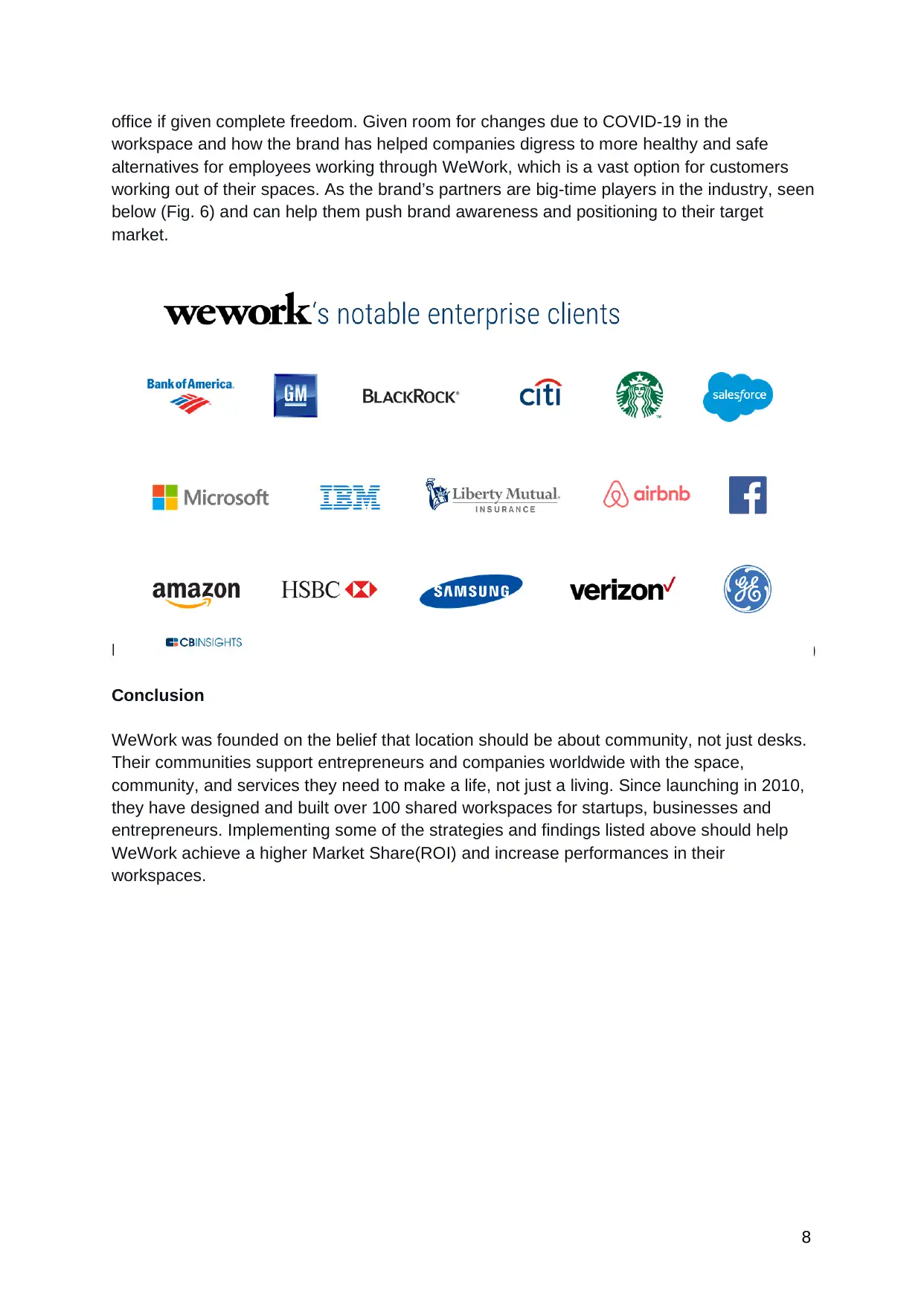
office if given complete freedom. Given room for changes due to COVID-19 in the
workspace and how the brand has helped companies digress to more healthy and safe
alternatives for employees working through WeWork, which is a vast option for customers
working out of their spaces. As the brand’s partners are big-time players in the industry, seen
below (Fig. 6) and can help them push brand awareness and positioning to their target
market.
Figure 6 (Data From; WeWork: WeWork | Office space and workspace solutions Anon.)
Conclusion
WeWork was founded on the belief that location should be about community, not just desks.
Their communities support entrepreneurs and companies worldwide with the space,
community, and services they need to make a life, not just a living. Since launching in 2010,
they have designed and built over 100 shared workspaces for startups, businesses and
entrepreneurs. Implementing some of the strategies and findings listed above should help
WeWork achieve a higher Market Share(ROI) and increase performances in their
workspaces.
8
workspace and how the brand has helped companies digress to more healthy and safe
alternatives for employees working through WeWork, which is a vast option for customers
working out of their spaces. As the brand’s partners are big-time players in the industry, seen
below (Fig. 6) and can help them push brand awareness and positioning to their target
market.
Figure 6 (Data From; WeWork: WeWork | Office space and workspace solutions Anon.)
Conclusion
WeWork was founded on the belief that location should be about community, not just desks.
Their communities support entrepreneurs and companies worldwide with the space,
community, and services they need to make a life, not just a living. Since launching in 2010,
they have designed and built over 100 shared workspaces for startups, businesses and
entrepreneurs. Implementing some of the strategies and findings listed above should help
WeWork achieve a higher Market Share(ROI) and increase performances in their
workspaces.
8
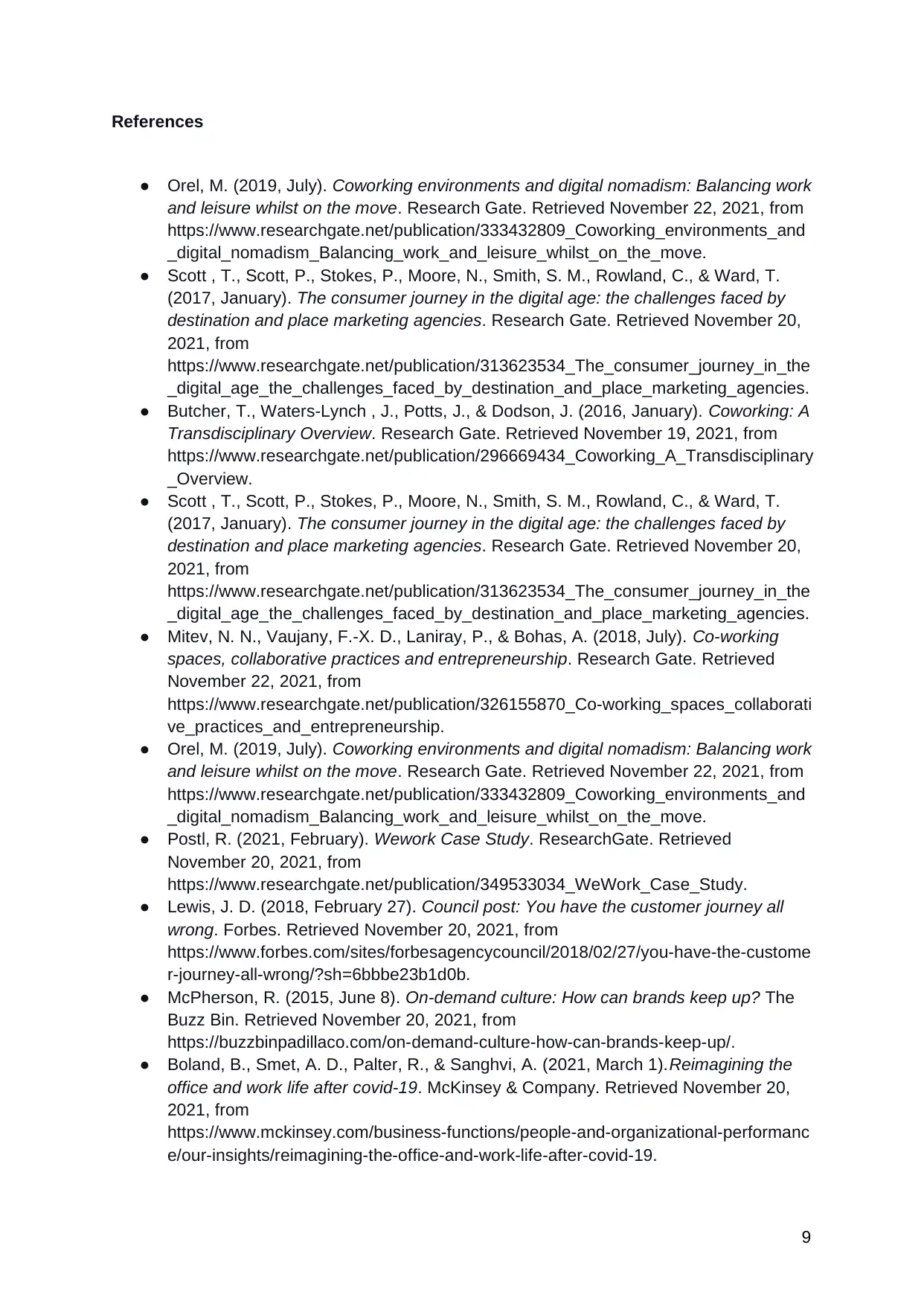
References
● Orel, M. (2019, July). Coworking environments and digital nomadism: Balancing work
and leisure whilst on the move. Research Gate. Retrieved November 22, 2021, from
https://www.researchgate.net/publication/333432809_Coworking_environments_and
_digital_nomadism_Balancing_work_and_leisure_whilst_on_the_move.
● Scott , T., Scott, P., Stokes, P., Moore, N., Smith, S. M., Rowland, C., & Ward, T.
(2017, January). The consumer journey in the digital age: the challenges faced by
destination and place marketing agencies. Research Gate. Retrieved November 20,
2021, from
https://www.researchgate.net/publication/313623534_The_consumer_journey_in_the
_digital_age_the_challenges_faced_by_destination_and_place_marketing_agencies.
● Butcher, T., Waters-Lynch , J., Potts, J., & Dodson, J. (2016, January). Coworking: A
Transdisciplinary Overview. Research Gate. Retrieved November 19, 2021, from
https://www.researchgate.net/publication/296669434_Coworking_A_Transdisciplinary
_Overview.
● Scott , T., Scott, P., Stokes, P., Moore, N., Smith, S. M., Rowland, C., & Ward, T.
(2017, January). The consumer journey in the digital age: the challenges faced by
destination and place marketing agencies. Research Gate. Retrieved November 20,
2021, from
https://www.researchgate.net/publication/313623534_The_consumer_journey_in_the
_digital_age_the_challenges_faced_by_destination_and_place_marketing_agencies.
● Mitev, N. N., Vaujany, F.-X. D., Laniray, P., & Bohas, A. (2018, July). Co-working
spaces, collaborative practices and entrepreneurship. Research Gate. Retrieved
November 22, 2021, from
https://www.researchgate.net/publication/326155870_Co-working_spaces_collaborati
ve_practices_and_entrepreneurship.
● Orel, M. (2019, July). Coworking environments and digital nomadism: Balancing work
and leisure whilst on the move. Research Gate. Retrieved November 22, 2021, from
https://www.researchgate.net/publication/333432809_Coworking_environments_and
_digital_nomadism_Balancing_work_and_leisure_whilst_on_the_move.
● Postl, R. (2021, February). Wework Case Study. ResearchGate. Retrieved
November 20, 2021, from
https://www.researchgate.net/publication/349533034_WeWork_Case_Study.
● Lewis, J. D. (2018, February 27). Council post: You have the customer journey all
wrong. Forbes. Retrieved November 20, 2021, from
https://www.forbes.com/sites/forbesagencycouncil/2018/02/27/you-have-the-custome
r-journey-all-wrong/?sh=6bbbe23b1d0b.
● McPherson, R. (2015, June 8). On-demand culture: How can brands keep up? The
Buzz Bin. Retrieved November 20, 2021, from
https://buzzbinpadillaco.com/on-demand-culture-how-can-brands-keep-up/.
● Boland, B., Smet, A. D., Palter, R., & Sanghvi, A. (2021, March 1).Reimagining the
office and work life after covid-19. McKinsey & Company. Retrieved November 20,
2021, from
https://www.mckinsey.com/business-functions/people-and-organizational-performanc
e/our-insights/reimagining-the-office-and-work-life-after-covid-19.
9
● Orel, M. (2019, July). Coworking environments and digital nomadism: Balancing work
and leisure whilst on the move. Research Gate. Retrieved November 22, 2021, from
https://www.researchgate.net/publication/333432809_Coworking_environments_and
_digital_nomadism_Balancing_work_and_leisure_whilst_on_the_move.
● Scott , T., Scott, P., Stokes, P., Moore, N., Smith, S. M., Rowland, C., & Ward, T.
(2017, January). The consumer journey in the digital age: the challenges faced by
destination and place marketing agencies. Research Gate. Retrieved November 20,
2021, from
https://www.researchgate.net/publication/313623534_The_consumer_journey_in_the
_digital_age_the_challenges_faced_by_destination_and_place_marketing_agencies.
● Butcher, T., Waters-Lynch , J., Potts, J., & Dodson, J. (2016, January). Coworking: A
Transdisciplinary Overview. Research Gate. Retrieved November 19, 2021, from
https://www.researchgate.net/publication/296669434_Coworking_A_Transdisciplinary
_Overview.
● Scott , T., Scott, P., Stokes, P., Moore, N., Smith, S. M., Rowland, C., & Ward, T.
(2017, January). The consumer journey in the digital age: the challenges faced by
destination and place marketing agencies. Research Gate. Retrieved November 20,
2021, from
https://www.researchgate.net/publication/313623534_The_consumer_journey_in_the
_digital_age_the_challenges_faced_by_destination_and_place_marketing_agencies.
● Mitev, N. N., Vaujany, F.-X. D., Laniray, P., & Bohas, A. (2018, July). Co-working
spaces, collaborative practices and entrepreneurship. Research Gate. Retrieved
November 22, 2021, from
https://www.researchgate.net/publication/326155870_Co-working_spaces_collaborati
ve_practices_and_entrepreneurship.
● Orel, M. (2019, July). Coworking environments and digital nomadism: Balancing work
and leisure whilst on the move. Research Gate. Retrieved November 22, 2021, from
https://www.researchgate.net/publication/333432809_Coworking_environments_and
_digital_nomadism_Balancing_work_and_leisure_whilst_on_the_move.
● Postl, R. (2021, February). Wework Case Study. ResearchGate. Retrieved
November 20, 2021, from
https://www.researchgate.net/publication/349533034_WeWork_Case_Study.
● Lewis, J. D. (2018, February 27). Council post: You have the customer journey all
wrong. Forbes. Retrieved November 20, 2021, from
https://www.forbes.com/sites/forbesagencycouncil/2018/02/27/you-have-the-custome
r-journey-all-wrong/?sh=6bbbe23b1d0b.
● McPherson, R. (2015, June 8). On-demand culture: How can brands keep up? The
Buzz Bin. Retrieved November 20, 2021, from
https://buzzbinpadillaco.com/on-demand-culture-how-can-brands-keep-up/.
● Boland, B., Smet, A. D., Palter, R., & Sanghvi, A. (2021, March 1).Reimagining the
office and work life after covid-19. McKinsey & Company. Retrieved November 20,
2021, from
https://www.mckinsey.com/business-functions/people-and-organizational-performanc
e/our-insights/reimagining-the-office-and-work-life-after-covid-19.
9
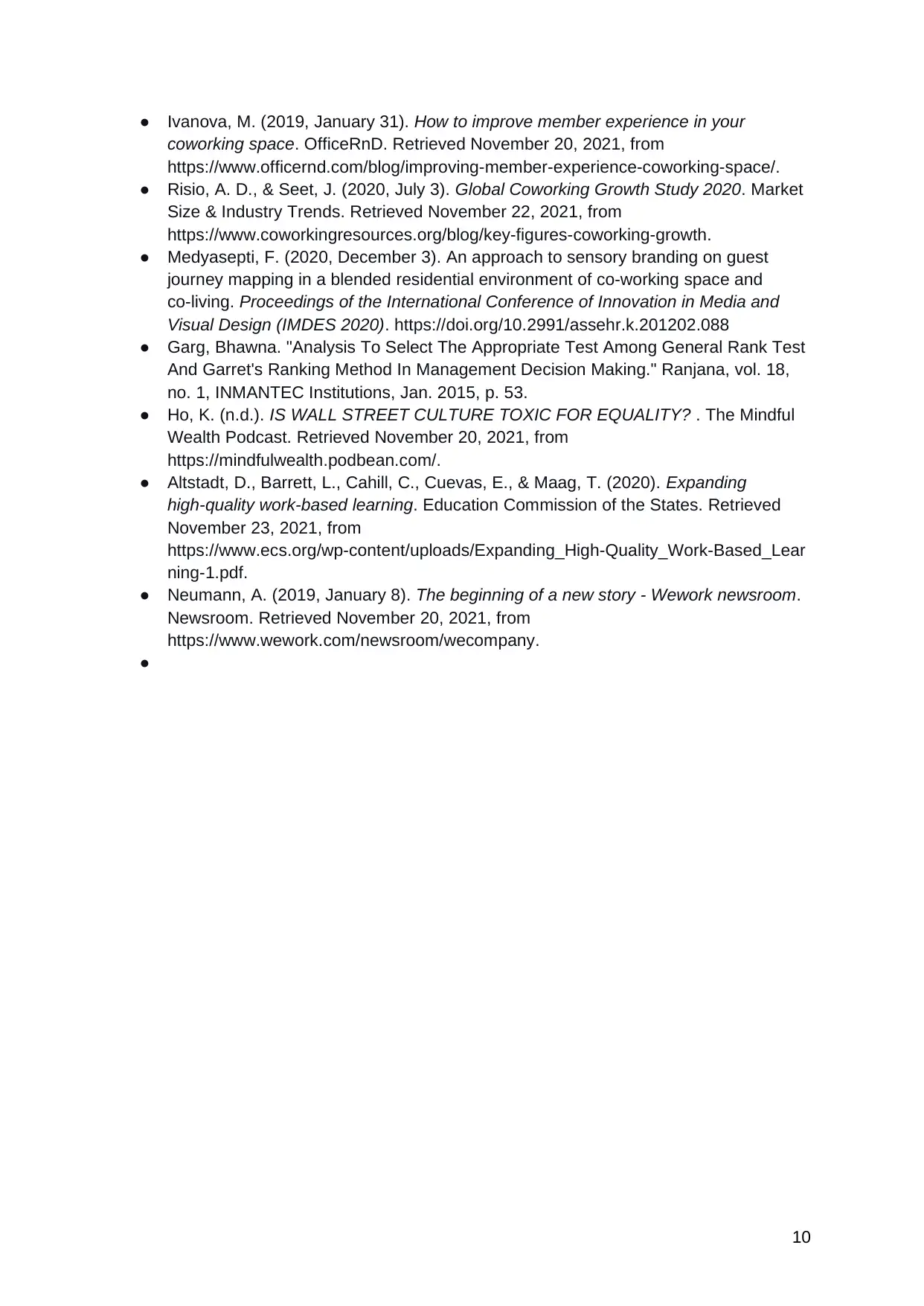
● Ivanova, M. (2019, January 31). How to improve member experience in your
coworking space. OfficeRnD. Retrieved November 20, 2021, from
https://www.officernd.com/blog/improving-member-experience-coworking-space/.
● Risio, A. D., & Seet, J. (2020, July 3). Global Coworking Growth Study 2020. Market
Size & Industry Trends. Retrieved November 22, 2021, from
https://www.coworkingresources.org/blog/key-figures-coworking-growth.
● Medyasepti, F. (2020, December 3). An approach to sensory branding on guest
journey mapping in a blended residential environment of co-working space and
co-living. Proceedings of the International Conference of Innovation in Media and
Visual Design (IMDES 2020). https://doi.org/10.2991/assehr.k.201202.088
● Garg, Bhawna. "Analysis To Select The Appropriate Test Among General Rank Test
And Garret's Ranking Method In Management Decision Making." Ranjana, vol. 18,
no. 1, INMANTEC Institutions, Jan. 2015, p. 53.
● Ho, K. (n.d.). IS WALL STREET CULTURE TOXIC FOR EQUALITY? . The Mindful
Wealth Podcast. Retrieved November 20, 2021, from
https://mindfulwealth.podbean.com/.
● Altstadt, D., Barrett, L., Cahill, C., Cuevas, E., & Maag, T. (2020). Expanding
high-quality work-based learning. Education Commission of the States. Retrieved
November 23, 2021, from
https://www.ecs.org/wp-content/uploads/Expanding_High-Quality_Work-Based_Lear
ning-1.pdf.
● Neumann, A. (2019, January 8). The beginning of a new story - Wework newsroom.
Newsroom. Retrieved November 20, 2021, from
https://www.wework.com/newsroom/wecompany.
●
10
coworking space. OfficeRnD. Retrieved November 20, 2021, from
https://www.officernd.com/blog/improving-member-experience-coworking-space/.
● Risio, A. D., & Seet, J. (2020, July 3). Global Coworking Growth Study 2020. Market
Size & Industry Trends. Retrieved November 22, 2021, from
https://www.coworkingresources.org/blog/key-figures-coworking-growth.
● Medyasepti, F. (2020, December 3). An approach to sensory branding on guest
journey mapping in a blended residential environment of co-working space and
co-living. Proceedings of the International Conference of Innovation in Media and
Visual Design (IMDES 2020). https://doi.org/10.2991/assehr.k.201202.088
● Garg, Bhawna. "Analysis To Select The Appropriate Test Among General Rank Test
And Garret's Ranking Method In Management Decision Making." Ranjana, vol. 18,
no. 1, INMANTEC Institutions, Jan. 2015, p. 53.
● Ho, K. (n.d.). IS WALL STREET CULTURE TOXIC FOR EQUALITY? . The Mindful
Wealth Podcast. Retrieved November 20, 2021, from
https://mindfulwealth.podbean.com/.
● Altstadt, D., Barrett, L., Cahill, C., Cuevas, E., & Maag, T. (2020). Expanding
high-quality work-based learning. Education Commission of the States. Retrieved
November 23, 2021, from
https://www.ecs.org/wp-content/uploads/Expanding_High-Quality_Work-Based_Lear
ning-1.pdf.
● Neumann, A. (2019, January 8). The beginning of a new story - Wework newsroom.
Newsroom. Retrieved November 20, 2021, from
https://www.wework.com/newsroom/wecompany.
●
10
1 out of 10
Your All-in-One AI-Powered Toolkit for Academic Success.
+13062052269
info@desklib.com
Available 24*7 on WhatsApp / Email
![[object Object]](/_next/static/media/star-bottom.7253800d.svg)
Unlock your academic potential
© 2024 | Zucol Services PVT LTD | All rights reserved.
